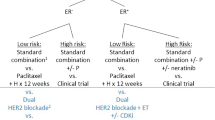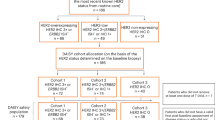Abstract
Purpose. To evaluate the predictive value of HER-2 in a population of advanced breast cancer patients randomly treated either with single-agent doxorubicin (A) or with single-agent docetaxel (T).
Experimental design. Patients from this study participated in a phase III clinical trial in which doxorubicin or docetaxel was administered for advanced disease. HER-2 was evaluated by IHC. In all positive cases, FISH was used to confirm the HER-2 positive status. The different cohorts of patients identified by HER-2 were examined to assess a possible relationship between HER-2 status and treatment effect.
Results. Tumor samples were available for 176 of the 326 patients entered in the clinical trial (54%). HER-2 positivity was observed in 20% of the study population. A statistically significant interaction was found between response rates to the study drugs and HER-2 status, with HER-2 positive patients deriving the highest benefit from the use of T (odds ratio for HER-2 positive patients treated with T = 3.12 (95% CI 1.11–8.80), p= 0.03). The interaction between HER-2 and response rates to A and T was also confirmed by a multivariate analysis. No statistically significant interaction was found between HER-2 and drugs efficacy evaluated in terms of time to progression and overall survival, although in the HER-2 negative cohort A was at least as effective as T in term of overall survival.
Conclusions. These results suggest that in HER-2 positive breast cancer patients docetaxel might be more active than doxorubicin, while in HER-2 negative patients doxorubicin might be at least as effective as docetaxel. Although the present results cannot have an impact on current practice, they allow us to formulate the hypothesis that HER-2 positive breast cancer is a heterogeneous disease with regard to sensitivity to anthracyclines and taxanes, and that this might be dependent upon other molecular markers including the p-53 and topoisomerase II alpha genes. This hypothesis is currently being tested prospectively in two different ‘bench to bed-side’ clinical trials.
Similar content being viewed by others
References
Chan S, Friedrichs K, Noel D, Pinter T, Van Belle S, Vorobiof D, Duarte R, Gil M, Bodrogi I, Murray E, Yelle L, von Minckwitz G, Korec S, Simmonds P, Buzzi F, Mancha R, Richardson G, Walpole E, Ronzoni M, Murawsky M, Alakl M, Riva A, Crown J: Prospective randomized trial of docetaxel versus doxorubicin in patients with metastatic breast cancer. J Clin Oncol 17: 2341–2354, 1999
Nabholtz JM, Senn HJ, Bezwoda WR, Melnychuk D, Deschenes L, Douma J, Vandenberg TA, Rapoport B, Rosso R, Trillet–Lenoir V, Orbal J, Molino A, Nortier JWR, Richel DJ, Nagykalnai T, Siedlecki P, Wilking N, Genot JY, Hupperets PSGJ, Pannuti F, Skarlos D, Tomiak EM, Murawsky M, Alakl M, Riva A, Aapro M: Prospective randomized trial of docetaxel versus mitomycin plus vinblastine in patients with metastatic breast cancer progressing despite previous anthracycline–containing chemotherapy. 304 Study Group. J Clin Oncol 17: 1413–1424, 1999
Mackey JR, Paterson A, Dirix LY, Dewar J, Chap L, Martin M, Chan S, Tang SC, Dugan W, Gil M, Zaluski J, Russel C, Vogel C, Efremedis A, Appia F, Brunel E, Hatteville L, Azli N, Nabholtz JM: Final results of the phase III randomized trial comparing docetaxel, doxorubicin and cyclophosphamide to FAC as first–line chemotherapy for patients with metastaticbreast cancer. Proc Am Soc Clin Oncol 21: 35a, 2002 (abstr no 137)
Nabholtz JM, Falkson G, Campos D, Szanto J, Martin M, Chan S, Pienkowski T, Bezwoda WR, Zaluski J, Pinter T, Krzakowski M, Vorobiof D, Leonard R, Kennedy I, Azli N, Murawsky M, Riva A, Pouillart P: A phase III trial comparing doxorubicin and docetaxel to doxorubicin and cyclophosphamide as first line chemotherapy for metastatic breast cancer. Proc Am Soc Clin Oncol 18: 127a, 1999 (abstr no 485)
Nabholtz JM, Pienkowski T, Mackey J, Pawlicki M, Guastalla JP, Vogel C, Weaver C, Walley B, Martin M, Chap L, Tomiak E, Juhos E, Guevin R, Howell A, Hainsworth J, Fornander T, Blitz S, Gazel S, Loret C, Riva A: Phase III trial comparing TAC (docetaxel, doxorubicin, cyclophosphamide) with FAC (fluorouracil, doxorubicin, cyclophosphamide) in the adjuvant treatment of node positive breast cancer patients: interim analysis of the BCIRG 001 study. Proc Am Soc Clin Oncol 21: 36a, 2002 (abstr no 141)
Di Leo A, Larsimont D, Gancberg D, Ferreira–Filho AF, Cardoso F, Piccart MJ: Predictive molecular markers: a new window of opportunity in the adjuvant therapy of breast cancer. In: Nabholtz JM, Tonkin K, Aapro MS, Buzdar AU (eds) Breast Cancer Management. Martin Dunitz, London, UK, 2000, pp 429–439
Thor AD, Berry DA, Budman DR, Muss HB, Kute T, Henderson IC, Barcos M, Cirrincione C, Edgerton S, Allred C, Norton L, Liu ET: Erb B–2, p–53 and efficacy of adjuvant therapy in lymph node–positive breast cancer. J Natl Cancer Inst 90: 1346–1360, 1998
Paik S, Bryant J, Park C, Fisher B, Tan–Chiu E, Hyams D, Fisher ER, Lippman ME, Wickerham DL, Wolmark N: erb B–2 and response to doxorubicin in patients with axillary lymph node–positive, hormone receptor–negative breast cancer. J Natl Cancer Inst 90: 1361–1370, 1998
Paik S, Bryant J, Tan–Chiu E, Yothers G, Park C, Wickerham DL, Wolmark N: HER–2 and choice of adjuvant chemotherapy for invasive breast cancer: National Surgical Adjuvant Breast and Bowel Project Protocol B–15. J Natl Cancer Inst 92: 1991–1998, 2000
Di Leo A, Larsimont D, Gancberg D, Jarvinen T, Beauduin M, Vindevoghel A, Michel J, Focan C, Ries F, Gobert P, Closon–Dejardin MT, Dolci S, Rouas G, Paesmans M, Lobelle JP, Isola J, Piccart MJ: HER–2 and topo–isomerase II α as predictive markers in a population of node–positive breast cancer patients randomly treated with adjuvant CMF or epirubicin plus cyclophosphamide. Ann Oncol 12: 1081–1089, 2001
Moliterni A, Menard S, Valagussa P, Biganzoli E, Boracchi P, Marubini E, Pilotti S, Bonadonna G: HER–2 overexpression and doxorubicin in the adjuvant chemotherapy of resectable breast cancer. Proc Am Soc Clin Oncol 20: 23a, 2001 (abstr no 89)
Pritchard KI, O'Malley FA, Andrulis I, Shepherd LE, Tu D, Levine MN, Bramwell VHC: Prognostic and predictive value of HER–2/neu in a randomized trial comparing CMF to CEF in premenopausal women with axillary lymph node positive breast cancer. Proc Am Soc Clin Oncol 21: 42a, 2002 (abstr no 165)
Konecny G, Thomssen C, Pegram M, Luck H, Untch M, Pauletti G, Dandekar U, Ramos L, Kuhn W, Eidtmann H, Dubois A, Olbricht S, Steinfeld D, Moebus V, von Minckwitz G, Slamon D: HER–2/neu gene amplification and response to paclitaxel in patients with metastatic breast cancer. Proc Am Soc Clin Oncol 20: 23a, 2001 (abstr no 88)
Miller AB, Hoogstraten B, Staquet M, Winkler A: Reporting results of cancer treatment. Cancer 47: 207–214, 1981
Gancberg D, Di Leo A, Cardoso F, Rouas G, Pedrocchi M, Paesmans M, Verhest A, Bernard–Marty C, Piccart MJ, Larsimont D: Comparison of HER–2 status between primary breast cancer and corresponding distant metastatic sites. Ann Oncol 13: 1036–1043, 2002
Tanner M, Jarvinen P, Isola J: Amplification of HER–2/neu and topoisomerase II α in primary and metastatic breast cancer. Cancer Res 61: 5345–5348, 2001
Namer M, Ettore F, Birtwhisle–Peyrottes I, Hartmann M, Hery M, Teissier E, Ferrero J, Largiller R: Comparison of c–erb–B2expression in 104 primary breast tumors and their metastases by two immunohistochemical tests. Proc Am Soc Clin Oncol 19: 653a, 2000 (abstr no 2577)
Lower EE, Yassin R, Bleau R, Heffelfinger SC: HER–2/neu expression in primary breast cancer correlates with metastatic disease expression. Proc Am Soc Clin Oncol 20: 425a, 2001 (abstr no 1697)
Edgerton SM, Merkel DE, Moore DH, Thor AD: HER–2/neu/Erb B–2 status by immunohistochemistry and FISH: clonality and progression with recurrence and metastases. Breast Cancer Res Treat 64: 55, 2000 (abstr no 180)
Järvinen TAH, Tanner M, Rantonen V, Barlund M, Borg A, Grenman S, Isola J: Amplification and deletion of topoisomeraseII α associate with Erb B–2 amplification and affect sensitivity to topoisomerase II inhibitor doxorubicin in breast cancer. Am J Pathol 156: 839–847, 2000
Di Leo A, Gancberg D, Larsimont D, Tanner M, Jarvinen T, Rouas G, Dolci S, Leroy JY, Paesmans M, Isola J, Piccart MJ: HER–2 amplification and toposisomerase II α gene aberrations as predictive markers in node–positive breast cancer patients randomly treated either with an anthracycline–based therapy or with cyclophosphamide, methotrexate and 5–fluorouracil. Clin Cancer Res 8: 1107–1116, 2002
Sorlie T, Perou CM, Tibshirani R, Aas T, Geisler S, Johnsen H, Hastie T, Eisen MB, van de Rijn M, Jeffrey SS, Thorsen T, Quist H, Matese JC, Brown PO, Botsein D, Lonning PE, Borresen–Dale AL: Gene expression patterns of breast carcinomas distinguish tumor subclasses with clinical implications. Proc Natl Acad Sci USA: 10869–10874, 2001
O'Connor PM, Jackman J, Bal I, Myers TG, Fan S, Mutch M, Scudiero DA, Monks A, Sausville EA, Weinstein JN, Friend S, Fornace AJ Jr, Kohn KW: Characterization of the p53 tumor suppressor pathway in cell lines of the National Cancer Institute anticancer drug screen and correlations with the growth–inhibitory potency of 123 anticancer agents. Cancer Res 57: 4285–4300, 1997
Lowe SW, Bodis S, Mc Clatchey A, Remington L, Ruley HE, Fisher DE, Housman DE, Jacks T: p53 status and the efficacy of cancer therapy in vivo. Science 266: 807–810, 1994
Aas T, Borresen AL, Geisler S, Smith–Sorensen B, Johnsen H, Varhaug JE, Akslen LA, Lonning PE: Specific p53 mutations are associated with de novo resistance to doxorubicin in breast cancer patients. Nat Med 2: 811–814, 1996
Lanni JS, Lowe SW, Licitra EJ, Liu JO, Jacks T: p–53–independent apoptosis induced by paclitaxel through an indirect mechanism. Proc Natl Acad Sci USA 94: 9679–9683, 1997
Author information
Authors and Affiliations
Rights and permissions
About this article
Cite this article
Di Leo, A., Chan, S., Paesmans, M. et al. HER-2/neu as a Predictive Marker in a Population of Advanced Breast Cancer Patients Randomly Treated Either with Single-agent Doxorubicin or Single-agent Docetaxel. Breast Cancer Res Treat 86, 197–206 (2004). https://doi.org/10.1023/B:BREA.0000036783.88387.47
Issue Date:
DOI: https://doi.org/10.1023/B:BREA.0000036783.88387.47




